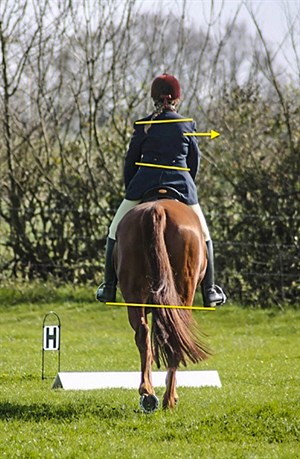
© Joingate | Dreamstime.com
We train our horses to be fit for their sport – but what about rider fitness? As fitness physio for the Australian eventing riders that trained for the Olympics, I believe riders should try to be as fit as their horses.
BY EMMA MATHLIN
RIDER FITNESS IS a growing area of interest among the equestrian population and researchers. We are now finding out much more about what physical requirements make for better riders, sounder horses and improved performance.
Horse and rider perform as one – the ultimate six-legged athlete – and both must be in peak physical condition to produce their best possible performance. Equestrian sports are complex and variable, requiring riders to have quick reaction times, exceptional strength, balance and endurance; all complicated by a large, powerful animal with its own mind.
There are a number of types of “fitness” that contribute to a peak rider condition:
AEROBIC ENDURANCE
Aerobic or cardiovascular endurance refers to how well the heart and lungs can deliver oxygen to the working muscles during prolonged exercise. We can think about it as how much power you have in your engine – do you want to be a Ferrari or an old Mini?
A rider with excellent aerobic endurance will be able to perform sustained exercise without fatiguing, giving them the ability to respond to sudden changes in conditions and to be more effective at making decisions quickly. Consider the effects of a tired rider on their horse – they may not be able to balance as well, be in sync with the horse movement, or apply the aids as smoothly resulting in poor performance or worse yet, risky situations.
There have been a handful of research studies to measure riders’ heart rates during riding to indicate how intense a variety of ridden activities are. Heart rates generally increase with faster gaits and reach very high rates during activities requiring the rider to be in two-point seat (eg racing, polo, jumping, galloping). This is probably because these activities use more leg muscle strength and require more trunk control.
Jenni-Louise Douglas, at the University of Worcester, England, is researching the physiological demands of eventing. She has been measuring riders’ heart rates, grip strength, blood lactate and also oxygen uptake, finding that a rider’s heart rate in a cross-country phase of eventing can reach an average of 85-95 per cent of their maximal heart rate for 5+ minutes. These results are supported by testing of Australian elite dressage and eventing riders during competition, finding that during dressage tests, riders are usually working at about 80 per cent of their maximum, and during cross-country greater than 90 per cent. In short, riding is hard work!
Preliminary work with Australia’s elite eventing riders is revealing that the elite performers have greater aerobic fitness, especially those who ride eight or more horses each day.
This graph show the heart rate and breathing rate of an elite Australian male eventer during the cross-country phase. His average heart rate was 176 beats per minute and average breathing rate 49 breaths per minute! (Close to his maximum for a period of 12 minutes).
Take-home message:
• Riding is hard work and requires good aerobic endurance.
• Being fitter will assist in maintaining good posture and balance on your horse – leading to less risk of injury to both horse and rider.
• Consider training at high aerobic intensities off the horse (consult a professional to set up an appropriate program for you).
MOBILITY
Our body needs to be flexible in certain areas to achieve the right position in the saddle. Elite riders have much better ankle flex than amateurs, especially those who jump. Riders’ backs also need to have good flexibility so that they can sit up tall in the saddle and absorb movement from the horse. Have you ever seen someone who struggles to sit to the trot? Often the cause is a stiff back and ankles! Another problem area can be the hip flexors – muscles at the front of the hips. Tightness here can lead to lower back pain and poor leg position in the saddle.
Take-home message:
• Consider seeing a qualified health professional who specialises in equestrian athletes to identify any problem areas and give you a stretching program to address them.
RIDER POSITION AND BODY SYMMETRY
Studies comparing elite and amateur rider position and movement patterns are revealing important information on the best way to sit and control the movement of the body in the saddle. What do professional riders do?
• Sit closer to the vertical.
• Have a more open hip angle.
• Carry their lower leg further underneath the body.
• Maintain greater ankle flex.
• Carry their arms further forward.
• Better synchronise their body movement with the horse, improving the regularity of the horse’s movement.
A rider sits asymmetrically in the saddle. You can easily see that her hips and shoulders aren’t level, her stirrup heights are uneven and her weight has shifted to the right.
© Joingate | Dreamstime.com
More and more research is looking at the influence of rider asymmetry on horse health and performance. Laterality, or a preference for using one side of the body over the other, is common amongst riders. Coaches insist on consistent and even aids from left to right, however, some studies have shown up to a 40% difference in pressure through the left and right reins. It’s little wonder that training misunderstandings, and horses not being straight and even, is common. It’s now also recognised that an asymmetrical rider can contribute to back pain and lameness in the horse.
The good news is that it is possible to improve your symmetry and core stability to have a positive effect on horse health and performance. Last year, Alexandra Hampson and colleagues at the University of Edinburgh conducted a study titled “Ten dressage riders took part in 3x20-minute rider specific core training sessions a week for 8 weeks”. After completing the training, riders exerted more even pressure through their seat bones onto the horses’ backs and horses showed a nearly 10 per cent increase in stride length.
Take-home message:
• Equestrian athletes require excellent strength, balance and stability.
• Rider asymmetry can contribute to back pain, lameness and poor performance of the horse.
• Exercise-training off the horse can improve symmetry and core stability, leading to better performance of rider and horse.
It is really important for the rider to consider themselves as part of the horse-rider athletic team. By training their fitness, a rider can contribute to much better athletic performance and prevent injury to themselves and their horse.
READ THE LATEST NEWS ARTICLES HERE
https://www.equestrianlife.com.au/articles/Fit-to-Ride

